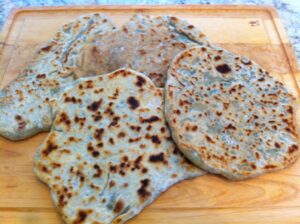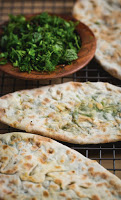

After reading a recipe for Jingalov (Djingialov) Hats in the AGBU cookbook, “Flavors with History – Armenian Cuisine”, I thought it might be interesting to try. It’s another Lenten-appropriate (vegan) recipe, and a reminder that it’s springtime.
With the bounty of fresh herbs currently available in our local farmers’ markets, gathering the necessary filling ingredients was no problem.
One source suggested using 20 different herbs, another said as many as 40 could be added to this bread.
20? 40? Really?? Well, I suppose you could, but that sounds like herbal overkill to me.
Creativity is key. Mix-and-match your favorite herbs; there are no set rules with this recipe. Use what’s available in your area, and what herbs you enjoy.
Wanting to be able to taste the individual herbs with each bite, I limited my herb selection to 5 – mint, tarragon, cilantro, thyme, and sage. (I understand that I violated a rule in this “no rules” recipe, by adding thyme to the mix. What can I say?)
To learn more about Jingalov Hats, read what my friend, Lena Tashjian, author of The Vegan Armenian Kitchen cookbook, has to say on this subject.
For the record, it is highly recommended to eat Jingalov Hats while sipping a good red wine.


Sts. Vartanantz Day is a moveable celebration on the Armenian Church calendar. This year it…
Just in time for soup season, Christine Datian offers The Armenian Kitchen her recipe for…
I don’t know about you, but in our family, we’re all about tradition when…
It’s that time of year again! St. Sarkis Day, the moveable feast day on the…
Way back in 2010 Ara Kassabian shared his family’s recipe for Nevik with The Armenian…
With Thanksgiving Day just hours away, I thought I’d share a few of our favorite,…
This website uses cookies. find out more.
View Comments
dear Lena Tachdjian,
the jingalov hats is never cooked in tonir. have you heard about SAJ???? it's like a bulging tray, on the fire. so as you have prepared it on a non-stick pen, it's wonderful.
the people of Artsakh used to put HONACHIR (dried Cornus) or GSOKHUR (Berberis vulgaris) in it. you can add some sumak instead of them to give some sour taste.
Dear Lena,
thank you for adding "Jingyalov hats" to the cooking book!
I am from Artsakh and live in Washington DC. You blog helped me to explain to my colleagues how I made it myself. I made my own Jingyalov hats for the first time yesterday and it turned out rather well.
I have seen my mom and my grandmas cooking it many times, but I have never tried it myself.
For the greens I used spinach, chervil, kale, chard (green part of red beets), cilantro, sorrel, green and yellow onions. And instead of "saj" which is usually made from cast iron I used my big cast iron pan.
Thank you for keeping Armenian culture alive. I use spinach instead of sorrel and lemon juice.
I cook them on a pre-heated griddle with nothing on it and they never stick. They come out looking like the picture.